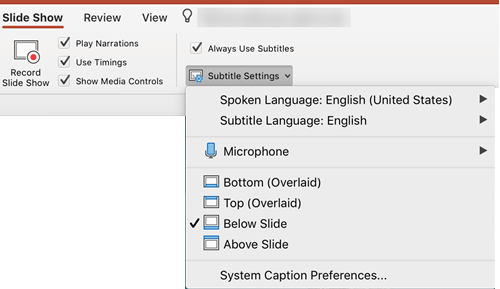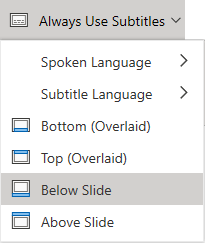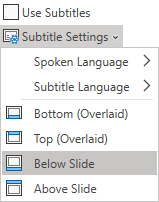PowerPoint for Microsoft 365 can transcribe your words as you present and display them on-screen as captions in the same language you are speaking, or as subtitles translated to another language. This can help accommodate individuals in the audience who may be deaf or hard of hearing, or more familiar with another language, respectively.
There are also position, size, color, and other appearance options for the captions and subtitles to accommodate different environments and audience needs.
For best results, we highly recommend using a headset microphone connected to the device running PowerPoint. Also, the feature requires a reliable internet connection throughout your presentation.
(Requires Windows 10, and PowerPoint for Microsoft 365 version 16.0.11601.20178 or higher on Current Channel. The feature isn't supported if you're using an earlier version of Windows.)
Set up captions and subtitles
You can choose which language you want to speak while presenting, and which language the caption/subtitle text should be shown in (i.e. if you want it to be translated). You can select the specific microphone you want to be used (if there is more than one microphone connected to your device), the position where the subtitles appear on the screen (bottom or top, and overlaid or separate from slide), and other display options.
-
On the Slide Show ribbon tab, select Subtitle Settings. Or, you can adjust the settings without leaving your presentation through the context menu, Slide Show or Presenter View menus > Subtitle Settings > More Settings.

-
Use Spoken Language to see the voice languages that PowerPoint can recognize, and select the one you want. This is the language that you will be speaking while presenting. (By default, this will be set to the language corresponding to your Office editing language.)
-
Use Subtitle Language to see which languages PowerPoint can display on-screen as captions or subtitles, and select the one you want. This is the language of the text that will be shown to your audience. By default, this will be the same language as your Spoken Language, but it can be a different language, meaning that translation will occur.
-
In the Subtitle Settings menu, set the desired position of the captions or subtitles. They can appear over the top or bottom margin of the slide (overlaid), or they can appear above the top or below the bottom of the slide (docked). The default setting is Below Slide.
-
More appearance settings are available by clicking Subtitle Settings > More Settings (Windows).
You can change the color, size, transparency, and font style of the subtitles. You can change the background to improve contrast and make text easier to read.
Turn the feature on or off while presenting
If you're in the middle of giving a presentation and want to turn the feature on or off, click the Toggle Subtitles button from Slide Show View or Presenter View, on the toolbar below the main slide:
In Slide Show View:

In Presenter View:

You can also toggle subtitles from the right-click menu, or with the shortcut key J.
To have subtitles always start up when a Slide Show presentation starts, from the ribbon you can navigate to Slide Show > Always Use Subtitles to turn this feature on for all presentations. (By default, it's off.) Then, in Slide Show and Presenter View, a live transcription of your words will appear on-screen.
(This feature requires PowerPoint for Microsoft 365 for Mac version 16.22.127.0 or higher.)
Set up captions and subtitles
You can choose which language you want to speak while presenting, and which language the caption/subtitle text should be shown in (i.e. if you want it to be translated). You can select the specific microphone you want to be used (if there is more than one microphone connected to your device), the position where the subtitles appear on the screen (bottom or top, and overlaid or separate from slide), and other display options.
-
On the Slide Show ribbon tab, select Subtitle Settings.

-
Use Spoken Language to see the voice languages that PowerPoint can recognize, and select the one you want. This is the language that you will be speaking while presenting. (By default, this will be set to the language corresponding to your Office language.)
-
Use Subtitle Language to see which languages PowerPoint can display on-screen as captions or subtitles, and select the one you want. This is the language of the text that will be shown to your audience. By default, this will be the same language as your Spoken Language, but it can be a different language, meaning that translation will occur.
-
In the Subtitle Settings menu, set the desired position of the captions or subtitles. They can appear over the top or bottom margin of the slide (overlaid), or they can appear above the top or below the bottom of the slide (docked). The default setting is Below Slide.
-
More appearance settings are available by clicking Subtitle Settings > System Caption Preferences.
You can change the color, size, transparency, and font style of the subtitles. You can change the background to improve contrast and make text easier to read.
Turn the feature on or off while presenting
If you're in the middle of giving a presentation and want to turn the feature on or off, click the Toggle Subtitles button from Slide Show View or Presenter View, on the toolbar below the main slide:
In Slide Show View:

In Presenter View:

(This feature is compatible with the following web browsers: Microsoft Edge, Google Chrome 34+, Mozilla Firefox 25+)
Set up captions and subtitles
You can choose which language you want to speak while presenting, and which language the caption/subtitle text should be shown in (i.e., if you want it to be translated). You can also select whether subtitles appear at the top or bottom of the screen.
Simplified Ribbon:

Classic Ribbon:

-
(Simplifed Ribbon) On the Slide Show ribbon tab, select the drop-down arrow next to Always Use Subtitles to open the menu of options.
(Classic Ribbon) On the View ribbon tab, select Use Subtitles. Then click Subtitle Settings to open the menu of options.
-
Use Spoken Language to see the voice languages that PowerPoint can recognize, and select the one you want. This is the language that you will be speaking while presenting. (By default, this will be set to the language corresponding to locale of your web-browser.)
-
Use Subtitle Language to see which languages PowerPoint can display on-screen as captions or subtitles, and select the one you want. This is the language of the text that will be shown to your audience. (By default, this will be the same language as your Spoken Language, but it can be a different language, meaning that translation will occur.)
-
Set the desired position of the captions or subtitles: they can appear overlaid at the top or bottom margin of the slide. The default setting is Bottom (Overlaid).
Turn the feature on or off while presenting
To have subtitles always start up when a Slide Show is presented, select View > Always Use Subtitles.
If you're in the middle of giving a presentation and want to turn the feature on or off, click the Use Subtitles button in Slide Show, on the toolbar below the main slide:

On/Off keyboard shortcut: J
Tips
-
If you see problems in the captions or subtitles, try speaking more deliberately.
-
Try to avoid or eliminate background noise that may interfere with your voice.
-
Captions & Subtitles depends on a cloud-based speech service, so it's important to have an internet connection that's fast and reliable.
Spoken languages supported by live captions & subtitles (voice input)
Several spoken languages are supported as voice input to live captions & subtitles in PowerPoint for Microsoft 365. The languages marked as Preview are offered in advance of full support, and generally will have somewhat lower accuracy, which will improve over time.
| Fully supported languages | Preview languages * |
|---|---|
| Chinese (PRC) | Arabic |
| English (Canada) | Danish |
| English (United Kingdom) | Dutch |
| English (United States) | English (Australia) |
| French (France) | English (India) |
| German (Germany) | Finnish |
| Italian (Italy) | French (Canada) |
| Spanish (Spain) | Hindi |
| Japanese | |
| Korean | |
| Norwegian | |
| Portuguese (Brazil) | |
| Russian | |
| Spanish (Mexico) | |
| Swedish |
* "Preview Languages" are not as fully supported at this time. Our recognition of these languages will improve over time.
On-screen languages supported by live captions & subtitles (text output)
PowerPoint for Microsoft 365 can display captions or subtitles on-screen in any of more than 60 languages:
| Afrikaans | Latvian |
| Arabic | Lithuanian |
| Bangla | Malagasy |
| Bosnian | Malay |
| Bulgarian | Maltese |
| Cantonese (Traditional) | Maori |
| Catalan | Norwegian (Bokmål) |
| Chinese (Simplified) | Persian |
| Chinese (Traditional) | Polish |
| Croatian | Portuguese |
| Czech | Querétaro Otomi |
| Danish | Romanian |
| Dutch | Russian |
| English | Samoan |
| Estonian | Serbian (Cyrillic) |
| Fijian | Serbian (Latin) |
| Filipino | Slovak |
| Finnish | Slovenian |
| French | Spanish |
| German | Swedish |
| Greek | Tahitian |
| Haitian Creole | Tamil |
| Hebrew | Telugu |
| Hindi | Thai |
| Hmong Daw | Tongan |
| Hungarian | Turkish |
| Icelandic | Ukranian |
| Indonesian | Urdu |
| Italian | Vietnamese |
| Japanese | Welsh |
| Kiswahili | Yucatec Maya |
| Korean |
Important information about live captions & subtitles
PowerPoint live captions & subtitles is one of the cloud-enhanced features in Microsoft 365 and is powered by Microsoft Speech Services. Your speech utterances will be sent to Microsoft to provide you with this service. For more information, see Make Office Work Smarter for You.
Technical support for customers with disabilities
Microsoft wants to provide the best possible experience for all our customers. If you have a disability or questions related to accessibility, please contact the Microsoft Disability Answer Desk for technical assistance. The Disability Answer Desk support team is trained in using many popular assistive technologies and can offer assistance in English, Spanish, French, and American Sign Language. Please go to the Microsoft Disability Answer Desk site to find out the contact details for your region.
If you are a government, commercial, or enterprise user, please contact the enterprise Disability Answer Desk.
See Also
Accessibility features in video playback on PowerPoint
Set up your device to work with accessibility in Microsoft 365
No comments:
Post a Comment